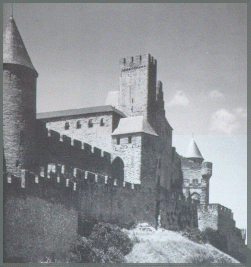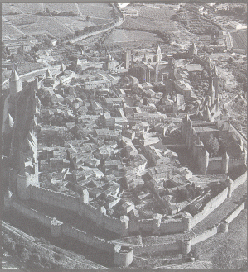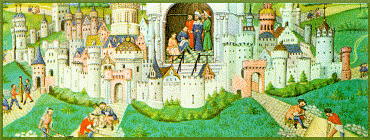

The walled town of Carcassonne in France
The Lady of Noroison's town is like some of the others described in this story, a walled town attached to a castle. Many towns in the Middle Ages belonged to a lord, or to a bishop or an abbot (being built on land belonging to an abbey, monastery, or cathedral).

Carcassonne from the air
Carcassonne is a typical medieval fortified city, easy to defend against attack. You can see how neatly the town fits inside its two sets of walls. In England some towns, like York, still have almost all of their medieval walls. Even in towns where the walls are no longer there, you can often still follow where they have been. A lot of towns still have traces of older Roman walls as well.
Yet not all towns belonged to castles or had been there since Roman times. During the Middle Ages, around 700 towns were built in England, and many that already existed grew larger. The population of England was getting bigger, and by the early 14th Century it had reached 3 million. Forests were being cleared, and swampy land drained for people to live on and grow crops.
More and more people came to the towns to work and live. If a serf (a peasant who belonged to a feudal lord) ran away from his lord and lived inside the walls of a town for a year and a day, he became a free man. People working in the same trades often lived in particular areas of a town: all the potters were together, all the weavers, the silversmiths, the leatherworkers and so on. You can sometimes guess which trades were carried on there from the street names today.

Laying roads out of a walled town